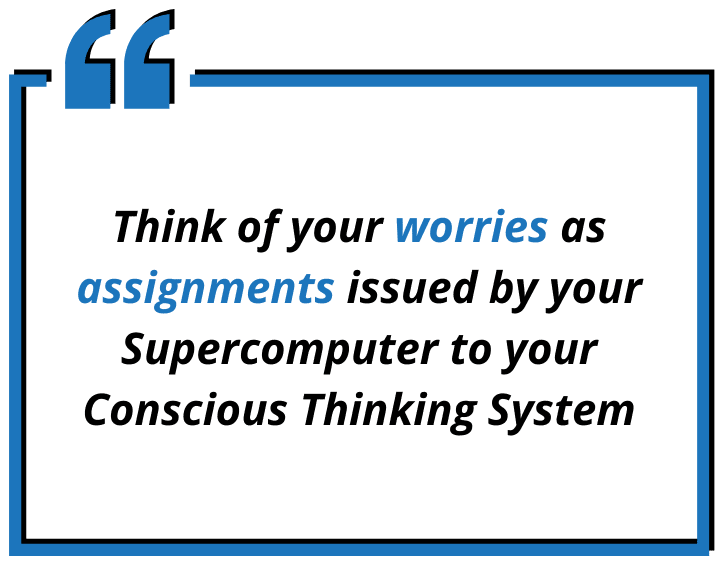Introduction
A Robot's Guide to Worry Part 1: Introduction
Welcome to A Robot’s Guide To Worry. The purpose of this series is to further define the robot mindset by applying it to a real world issue that so many of us deal with: excessive worry. Through the five parts of this series, we will weave many core concepts found here at Confident Robot into a practical format. Part 1 of this series will expand upon the robot metaphor and then address why our mechanical brains are so inclined towards worry. Then in Parts 2-5, we will discuss various techniques to help us worry less and problem-solve better.
Techniques To Help Neutralize Worry
To begin, let’s get to know a couple of the players involved in the drama that is our mental life. The collection of unconscious processes is our first character; let’s call it the Unconscious Supercomputer (or just Supercomputer for short). The other major player on our stage is our conscious thinking; we’ll refer to it as the Conscious Thinking System. (This division maps nicely onto the System 1 and System 2 distinction of dual process theory. For more information on this, I recommend Thinking, Fast And Slow by Daniel Kahneman.) Now that we’ve made our introductions, let’s talk about each of these characters’ roles in our lives.
The Unconscious Supercomputer
The Unconscious Supercomputer, for the most part, runs the show. It is powerful, operates very quickly, and can perform many tasks at once. Its processes are automated and occur without conscious effort. The Supercomputer plays a significant role in guiding our day-to-day actions and setting the overall course of our lives. These processes subtly yet directly affect our emotions, decisions, behaviors, conscious thoughts, and yes… the worries that pop into our heads.
The Conscious Thinking System
In contrast, the Conscious Thinking System is slow, can only perform one task at a time, and its operation feels effortful to us. The Conscious Thinking System is not in charge in the way that it seems, though it does have an important role to play. Think of it as a specialist side player. The Conscious Thinking System can do some fancy analytical processing that cannot be done unconsciously.
Additionally, the Conscious Thinking System can imagine the future and create detailed hypothetical scenarios. This is an amazing ability that no other animal can perform. This allows us to consider different courses of action and imagine what the various outcomes might be. It allows us to scheme and plan and problem-solve in advance.
Life on Autopilot
For the most part, we move through our days in an autopilot-like way. The Supercomputer knows what we need to do next, and we do it without much conscious consideration. Sometimes, however, the next move is not clear, and the Supercomputer sends an assignment up to the Conscious Thinking System: “Hey Conscious Thinking System, I want to meet that attractive person across the room, why don’t you use that fancy processor of yours and come up with some potential ways to go about it. Give me some options, and I will pick the one I like.” This grossly oversimplified example is actually more true than not. Though it feels like we make our decisions consciously and logically, there is much evidence to support the idea that decisions are dependent on unconscious, emotion-based circuits within the brain. To learn more, visit my page entitled Who’s In Charge?
To Worry or Not To Worry?

With our characters firmly established, we will now turn our attention to worry. To begin, let us consider the adaptive purpose of worry. Your brain is an amazing problem-solving machine, and the process of worry serves to help us put that machine into gear. Worries often represent problems that need to be solved or potentially threatening situations that we want to figure out how to avoid. Worries are produced by the Supercomputer and pumped up into consciousness for the purpose of enlisting the imaginative, analytic powers of the Conscious Thinking System. Think of your worries as assignments issued to your Conscious Thinking System by the Supercomputer. “Hey Conscious Thinking System, we are having some trouble at work, and I am not so sure how to proceed; why don’t you spend the rest of the night planning for every possible nightmare scenario.”
Oftentimes, this system works pretty well. By getting the Conscious Thinking System to pay attention to the issue and enlisting its resources, we come up with effective plans and avoid unnecessary mistakes. In this way, we can frequently see worry as effective in helping us solve problems. But unfortunately, this is not always the case. Despite the importance of the worry mechanism, it has the tendency to go a little haywire. Sometimes, we may feel as though our worries are not actually helping us to resolve or prevent anything. We find our Conscious Thinking System wrapped up in the assignment issued by the Supercomputer, despite the fact that further thought and rumination will likely not provide any practical value for us. We will refer to these as unproductive worries.
In some instances, we arrive at this unproductive juncture because we have already spent a lot of the Conscious Thinking System’s precious resources working on the problem without making progress. Though the Conscious Thinking System has its talents and can lend a hand in a way that no other part of the brain can, it still is not the true workhorse within the problem-solving realm. Much of what is needed for resolution occurs within the Supercomputer (see Who’s In Charge? for more info). There are times when further conscious effort is not what we really need. In these instances, our best course of action can be to give it a rest and engage in something else for the time being. The Supercomputer will continue working in the background.
Fish Out of Water
Another scenario where we might find ourselves wrapped up in unproductive worry is when we are concerned about things that we can’t control. If something is not under our control, if we cannot affect the outcome, what possible good could a bunch of rumination serve? You likely are familiar with this situation. Why does this occur? One big reason is because of the way we are wired up. Our brains have been designed through hundreds of thousands of years of evolution to help us survive. Because evolution takes place so slowly, much of the Supercomputer’s hardwiring has been slowly calibrated to the lifestyle of our hunter-gatherer ancestors. We run into problems in the present-day because our circumstances and daily challenges are so different from those we were designed for. We are all fish out of water in the modern environment.
To understand the implications of this in terms of stress and worry, consider that our ancestors’ environment was harsh; life was brutish and short. There were many ways to meet your untimely end. For example, the ability to store or preserve food was extremely limited, and your next meal was never guaranteed. Sabertooth tigers and many other now-extinct predators were commonplace. There was no system of law and order, and encountering another band of humans often resulted in violence. Something as simple as being caught in a rainstorm too far from your shelter could lead to hypothermia and death. Even social interactions with members of your own tribe had mortal implications. To lose favor with your group and to be kicked out was to be left for the wolves.
Many of the day-to-day decisions that our ancestors made had life-and-death consequences. It is against this backdrop that we can begin to understand why our hardwired stress response and tendency to worry are set so high. In the modern environment, almost none of the challenges we face have anything near life-and-death consequences. Even though our lives no longer hang in the balance based on everyday decisions, our caveman brains often react with an urgency as if they did, and we have a tendency to overthink situations that do not warrant this level of concern.
Furthermore, despite life being more dangerous in ancestral times, it was much less complex. We now have many more decisions to make, things to think and worry about, odd challenges to face, and situations to frustrate us. We are full of instincts to help us resolve various problems and worries, but again, these mostly relate to the types of challenges one might encounter in tribal life. Consider for a moment many abstract modern tasks, such as comparing insurance policies, deciding to lease or buy, choosing how to invest our savings, or even something as mundane as choosing amongst 23 similar products on Amazon. It’s not to say that we can’t solve these types of problems, but it is not something we do intuitively and smoothly. Often the Supercomputer’s emotional response in these types of situations makes resolution more difficult than it needs to be, and we find ourselves spinning our wheels.
Further, consider that our instinctual mechanisms of worry were honed long before the invention of television. If we witness or hear about something bad happening to someone, we are designed to worry about it. This makes perfect sense in tribal life. If something bad happened to one of your friends, you would likely have good reason to be concerned about it happening to you. In modern times, we are exposed to every major calamity that occurs on the entire planet of 7 billion, and our worry response goes haywire.
Because evolution designed our emotional guidance system to help us thrive within a dangerous landscape, we have an instinctive tendency to take a better-safe-than-sorry approach to the world. Modern living creates many situations where the Supercomputer doesn’t know what to do, so it errs on the side of caution and issues worry assignments to the Conscious Thinking System. We will often get wrapped up in these even if it is something that we can rationally realize is not within our control, extremely unlikely, or otherwise unproductive. Despite our natural tendency, there are ways to combat this.
Coming Up:
To understand that many of your worries are mechanical products that misfire due to the modern environment is an empowering idea. In Parts 2 and 3 of this guide, we will combine this notion with several mindfulness techniques to provide you with tools to help you more effectively deal with unproductive worries. But of course, not all of your worries are unproductive. Oftentimes, the issues that you find yourself worrying about do involve decisions that need to be made and circumstances over which you do have some influence. Parts 4 and 5 will cover these instances. We will discuss several techniques to help you problem-solve better and make your worries more productive.
Next up: Part 2 of this series.
